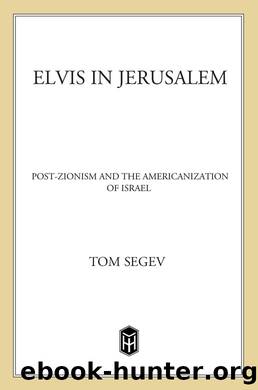Elvis in Jerusalem by Tom Segev

Author:Tom Segev
Language: eng
Format: epub
Publisher: Henry Holt and Co.
Published: 2011-05-23T00:00:00+00:00
In November 1957 a boy named Aharon Steinberg died in the village of Pardes Hanna. His mother was not Jewish, so the boy was buried not in the main part of the local cemetery, but âoutside the fence.â A public scandal ensued, in the wake of which the minister of interior, Yisrael Bar-Yehuda, ordered that new immigrants should be registered as Jews upon their own declaration, unless it was possible to prove otherwise. The ministerâs order produced an even stormier debate. The religious parties demanded that the official rabbinate be the sole judge of a personâs Jewish status, in accordance with the general rule that âthe State of Israel will consider Jewish anyone who is considered Jewish according to the laws of the Torah.â The parties of the left demanded, in turn, that the state cease altogether to register the ethnic affiliation and religion of its inhabitants.
As the controversy grew ever more heated, Prime Minister David Ben-Gurion wrote to several dozen âwise Jewsâârabbis, thinkers, and writersâand asked their opinion on the question of âwho is a Jew.â His very willingness to hear the opinions of non-Zionist rabbis, some of whom did not even live in Israel, was a concession on his part, as if Israel were recognizing that Jews living overseas had a right to intervene in internal affairs. Throughout the years the Supreme Court was petitioned over and over again to rule on who is a Jew. The question has continued to weigh on the Israeli public and has remained without any consensual solution. The present legal situation is that in matters of personal status, such as marriage and divorce, Jewish affiliation is awarded only to people with Jewish mothers, or to those who have been converted to Judaism by an Orthodox rabbinical court. To receive Israeli citizenship under the Law of Return, it is sufficient to have one Jewish grandparent: such citizens may bring non-Jewish relatives into the country.
The conflict over religionâs place in the state has been resolved for the most part through practical compromises of one sort or another, by means of political negotiations. All these arrangements indicate that Israeli culture has not succeeded in formulating a relevant alternative to Jewish culture. In the 1930s most kibbutzim did away with observance of the Sabbath and the dietary laws, and in some cases religious marriage and burial as well. Here and there they tried to design secular alternatives to holiday ceremonies and even composed secular texts to recite on these occasions. The kibbutz movement published a secular Hagadah.
These alternatives did not, however, produce a real secular culture. Uriel Simon wrote: âThe important and lasting achievements of 200 years of secular Jewish creativity in the spirit of the Enlightenment are not a sufficient foundation for constructing an Israeli national-cultural identity. Furthermore, these achievements themselves stand on the shoulders of 3,000 years of creativity that is principally religious in nature.â The common Jewish foundation that is shared by most of Israelâs citizens, including those who are not religious, has prevented the tension from degenerating into an absolute break.
Download
This site does not store any files on its server. We only index and link to content provided by other sites. Please contact the content providers to delete copyright contents if any and email us, we'll remove relevant links or contents immediately.
| Africa | Americas |
| Arctic & Antarctica | Asia |
| Australia & Oceania | Europe |
| Middle East | Russia |
| United States | World |
| Ancient Civilizations | Military |
| Historical Study & Educational Resources |
Machine Learning at Scale with H2O by Gregory Keys | David Whiting(4199)
Never by Ken Follett(3800)
Fairy Tale by Stephen King(3227)
The Man Who Died Twice by Richard Osman(2998)
Oathbringer (The Stormlight Archive, Book 3) by Brandon Sanderson(2902)
Will by Will Smith(2795)
Rationality by Steven Pinker(2292)
The Dark Hours by Michael Connelly(2246)
Can't Hurt Me: Master Your Mind and Defy the Odds - Clean Edition by David Goggins(2230)
Friends, Lovers, and the Big Terrible Thing by Matthew Perry(2126)
The Dawn of Everything: A New History of Humanity by David Graeber & David Wengrow(2123)
Principles for Dealing With the Changing World Order: Why Nations Succeed and Fail by Ray Dalio(1974)
HBR's 10 Must Reads 2022 by Harvard Business Review(1782)
A Short History of War by Jeremy Black(1764)
Go Tell the Bees That I Am Gone by Diana Gabaldon(1690)
515945210 by Unknown(1602)
A Game of Thrones (The Illustrated Edition) by George R. R. Martin(1595)
Kingdom of Ash by Maas Sarah J(1531)
443319537 by Unknown(1472)
